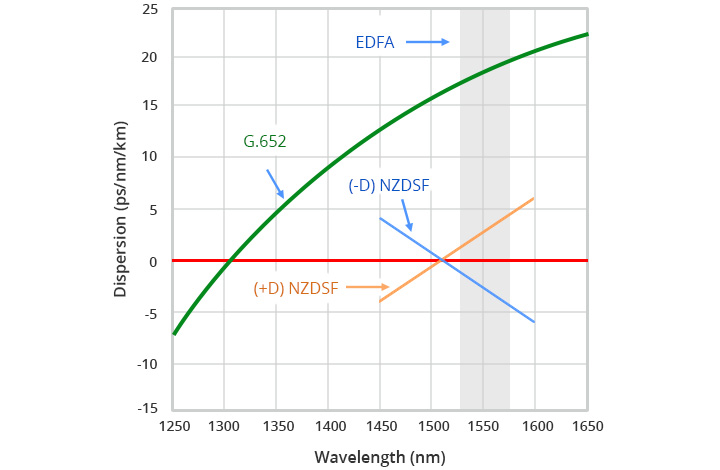- English
- German
- French
- Spanish
- Japanese
- Italian
- Chinese
- Chinese (traditional)
- Home
- Blog
- Case Study
- Knowledge Center
- Glossary
- Story
- Video
- Blog Type
- Product
- Topic
- Region
Hot Search
- Product Updates
- Share FS
- PoE Switch
- Networking
- Networking Devices
- Home
- Blog
- Case Study
- Knowledge Center
- Glossary
- Story
- Video
-
- Home
- Blog
- Case Study
- Knowledge Center
- Glossary
- Story
- Video
- Blog Type
- Product
- Topic
- Region
- Home
- Blog
- Case Study
- Knowledge Center
- Glossary
- Story
- Video
- English
Hot Search
- Product Updates
- Share FS
- PoE Switch
- Networking
- Networking Devices
Single Mode Fiber Comparison: G.652 vs G.655
ITU-T G.65x series is a commonly known single mode fiber standard category, which can be further divided into G.652, G.653, G.654, G.655, G.656, and G.657, among which G.652 and G.655 are the two options commonly used. This article will primarily focus on the comparison between G.652 vs G.655 fibers, and providing guidance on making an informed decision between the two.
Introduction to G.652 Fiber Optic Cable
The first edition of G.652 fiber cable was standardized in 1984 and now this standard has four subcategories: G.652.A, G.652.B, G.652.C, and G.652.D. All of the four variants have the same G.652 core size of 8-10 micrometers. Among them, G.652.C and G.652.D fibers possess higher performance than G.652.A and G.652.B.
For the G.652 divisions, the G.652.A and G.652.B fibers are designed to have a zero-dispersion wavelength near 1310nm—optimal for operation in the 1310nm band. Due to the water peak nature, both of them are not suitable for Wavelength Division Multiplexing (WDM) applications. The more advanced variants G.652.C and G.652.D fibers have eliminated the water peak for full spectrum operation, allowing them to be applied in the wavelength region between 1310nm and 1625nm to support Coarse Wavelength Division Multiplexed (CWDM) transmission. Here is a specification table of the four G.652 fiber types.
| G.652.A | G.652.B | G.652.C | G.652.D | |
|---|---|---|---|---|
| Wavelength Range | 1310nm-1550nm | 1310nm-1625nm | 1310nm-1625nm | 1310nm-1625nm |
| Maximum Attenuation Coefficient | 1310nm: 0.5dB/km 1550nm:0.4dB/km | 1310nm: 0.4dB/km 1550nm: 0.35dB/km 1625nm: 0.4dB/km | 1310nm to 1625nm: 0.4dB/km 1383 nm ± 3 nm: 0.4dB/km 1550nm: 0.3dB/km | 1310nm to1625nm: 0.4dB/km 1383nm± 3nm:0.4dB/km 1530-1565nm: 0.3dB/km |
| Application | Support applications such as 10G, 40G, 10G up to 40km | Some higher bit rate applications like 10G | Similar to G.652.A. However, transmission bands extended to E, S and L. Suitable for CWDM systems | Similar to G.652.B. However, transmission bands extended to E and S. Suitable for CWDM systems |
|
E band stands for the wavelength range from 1360nm to 1460nm. S band refers to the wavelength range from 1460nm to 1530nm. C band is the conventional one with the wavelength range from 1530nm to 1565nm. L band represents the wavelength range from 1565nm to 1625nm. |
||||
Introduction to G.655 Fiber Optic Cable
G.655 standard can be divided into G.655.A, G.655.B, G.655.C, G.655.D, and G.655.E five variants, among which the G.655 C/D/E are commonly-used ones. G.655 single-mode fiber is known as Non Zero Dispersion-shifted Fiber (NZDSF) on account of the dispersion at the wavelength of 1550nm—close to zero but not zero yet. There are two types of NZDSF: (-D) NZDSF and (+D) NZDSF, which stand for a negative and positive slope versus wavelength respectively, as shown in the following figure.

The G.655 fiber optic cable has a small, controlled amount of chromatic dispersion in the C-band (1530-1565nm), where amplifiers work best, and has a larger core area than G.652 fiber optic cable. As an improved dispersion-shifted fiber, G.655 can suppress four-wave mixing and other nonlinear effects. Therefore, G.655 single-mode fiber that supports longer distances with higher capacity can meet the requirements of Dense Wavelength Division Multiplexed (DWDM) transmission.
Here is a specification table of the three frequently-used G.655 fiber types.
| template | G.655.C | G.655.D | G.655.E |
|---|---|---|---|
| Wavelength Range | 1550-1625nm | 1550-1625nm | 1550-1625nm |
| Maximum Attenuation Coefficient | 1550nm: 0.35dB/km 1625nm: 0.4dB/km | 1550nm: 0.35dB/km 1625nm: 0.4dB/km | 1550nm: 0.35dB/km 1625nm: 0.4dB/km |
| Application |
(1) Recommendations such as G.691, G.959.1, and G.693. (2) For DWDM systems, channel spacings defined in G.694.1 are supported, depending on the minimum dispersion that is selected. |
(1) For wavelengths greater than 1530 nm, the applications mentioned in G.655.C are supported. (2) For wavelengths less than 1530 nm, the fiber can be used to support CWDM applications at channels from 1471nm and higher. |
(1) The same style as G.655.D, but with higher values especially for some small channel spacings. (2) The applications mentioned in G.655.C are supported. |
G.652 vs G.655 SMF Cables: Which to Choose?
G.652 standard is designed for LAN, MAN, access networks and CWDM transmission. CWDM is an economically sensible option, often used for short-haul applications on G.652 fiber cables, where signal amplification is not necessary. G.655 is the second most common fiber type in terrestrial networks and has been widely deployed in long-haul networks and DWDM transmission. The key value position for this fiber type was low dispersion including Chromatic Dispersion and Polarization Mode Dispersion (PMD) when deployment.
The selection of a single-mode fiber optic cable will depend on your needs. The G.652 fiber optic cable and its posterior evolution version G.657 fibers are low-cost fibers, standard and qualified for those that don't require speed higher than 10Gbps with short-haul distances. G.652 is recommended for this kind of case. If your desired bandwidth is higher than 10Gbps or needs to support over long distances with higher performance, G.655 can provide a better solution regardless of much higher cost. The following chart shows the applications for CWDM/DWDM of G.652 vs G.655. The one with a mark indicates the standard is suitable for the application.
| 10G CWDM | 40G CWDM | 10G DWDM | 40G DWDM | 100G DWDM | |
|---|---|---|---|---|---|
| G.652 fiber cable | √ | N/A | N/A | N/A | N/A |
| G.655 fiber cable | √ | √ | √ | √ | √ |
Conclusion
Different types of single-mode fiber cables have their application areas. Choosing the right SMF for your cabling is important, taking performance, cost and reliability into consideration. Choosing the right fiber optic cable can be confusing due to the various standards available. Our article Is G.652 Single Mode Fiber Your Right Choice may give you some inspiration before selecting.
You might be interested in




Email Address

-
PoE vs PoE+ vs PoE++ Switch: How to Choose?
May 30, 2024

























































